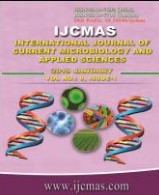


 National Academy of Agricultural Sciences (NAAS)
National Academy of Agricultural Sciences (NAAS)

|
PRINT ISSN : 2319-7692
Online ISSN : 2319-7706 Issues : 12 per year Publisher : Excellent Publishers Email : editorijcmas@gmail.com / submit@ijcmas.com Editor-in-chief: Dr.M.Prakash Index Copernicus ICV 2018: 95.39 NAAS RATING 2020: 5.38 |
Bioethanol is one of the promising alternative fuels to gasoline in the transport sector. Ethanol may be produced either from petroleum products or from biomass. In the world around 80% of the ethanol produced is still obtained from fermentation and the reminder comes largely by synthesis from the petroleum product ethylene (Tanaka, 2006). Cotton stalks have been regarded as potential sources for cellulosic ethanol production owing to their high cellulose content being almost 37% (Binod et al., 2012). Hence, there is a need of utilizing available biomass resources for production of ethanol to reach energy demand. Compounding the challenges is the fact that the country lacks mature technologies for ethanol production from lignocellulosic biomass which is by far the most abundant renewable resource that may be exploited (Lynd et al., 2002; Zhang, 2008). The goal of the pretreatment process is to remove lignin and hemicellulose, reduce the crystallinity of cellulose, and increase the porosity of the lignocellulosic materials. This study is aimed at investigating the effect of potassium hydroxide (KOH) on cotton stalks for optimization of pre-treatment conditions on solids recovery, delignification and total sugars. Potassium hydroxide (KOH) pre-treatment was performed at 50 °C, 70 °C with residence times of 6, 12, and 24 h and 120 °C with residence times of 0.25, 0.5 and 1 h each. All the temperature–time pretreatment combinations were performed with potassium hydroxide (KOH) concentrations of 1, 2 and 3%. Solid recoveries, AIL, ASL, total sugars, cellulose and hemicelluloses content after each pretreatment ranged between 49.60-85.04%, 10.19-23.96%, 1.51-1.95%, 268.01-419.51(mg/g dry biomass), 33.00-53.54% and 1.17-14.04% respectively. Maximum lignin reductions at different temperatures were all obtained at the combinations of highest KOH concentrations and longest treatment times, which indicated a close relationship between pretreatment severity and lignin reduction.
 |
 |
 |
 |
 |